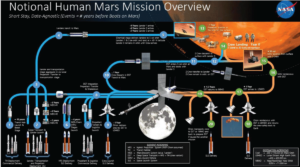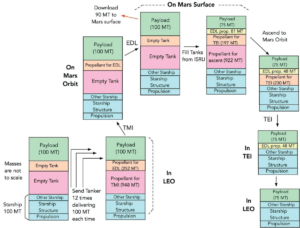Will SpaceX Send Humans to Mars in 2028?
Introduction As we stand on the cusp of interplanetary travel, SpaceX’s ambitious plan to send humans to Mars by 2028 poses a series of groundbreaking challenges and innovations in the field of physics. This post delves deep into the complexities and feasibility of such a mission, exploring how cutting-edge advancements in physics could potentially turn science fiction into reality. For an in-depth exploration, refer to the full text and PDF of the study.
The Core Physics Behind SpaceX’s Mars Mission SpaceX’s plan involves using its Starship spacecraft, designed to transport large payloads and crew to Mars. The mission’s success hinges on several key physics-based components:
- Orbital Mechanics: The journey to Mars requires precise calculations to successfully navigate the spacecraft between Earth and Mars. This includes determining the optimal launch windows, minimizing fuel consumption through Hohmann transfer orbits, and managing the delta-v (change in velocity) requirements for interplanetary travel.
- Propulsion Systems: SpaceX plans to utilize its Raptor engines powered by methane (CH4) and oxygen (O2), which are crucial for the Starship’s propulsion. Understanding the thermodynamics and fluid mechanics of these propellants under extreme conditions is vital for ensuring reliability and efficiency.
- Entry, Descent, and Landing (EDL) on Mars: The physics of reducing a spacecraft’s speed from orbital velocities to a safe landing speed involves complex aerodynamic and heat transfer calculations. The Starship will need to withstand high temperatures and aerodynamic forces during Martian atmospheric entry.
Challenges and Solutions in Physics The mission faces several physics-related challenges:
- Massive Payloads: Landing a 100 metric ton Starship on Mars requires advanced understanding and application of physics to manage the stresses and strains on the spacecraft during EDL.
- In-Situ Resource Utilization (ISRU): Physics plays a crucial role in developing technologies for producing methane and oxygen on Mars. This involves chemical reactions that must be catalyzed under Martian environmental conditions.
- Sustainable Life Support Systems: The physics of closed-loop life support systems, which recycle water and air, are critical for the long-duration stay on Mars.
Innovations Driven by Physics SpaceX’s approach includes several innovations rooted in physics:
- Reusability of Starship: Understanding material science and structural physics allows SpaceX to develop a spacecraft that can withstand multiple entries and exits from planetary atmospheres.
- Energy Management: The efficient conversion and storage of energy, crucial for powering the spacecraft and surface operations on Mars, involve advanced physics in photovoltaics and battery technology.
Implications for Public Health The mission’s success has direct implications for public health on Mars, especially in terms of developing physical protection against cosmic and solar radiation, ensuring the physical well-being of astronauts in reduced gravity, and managing the circadian rhythms of the crew in an alien environment.
Graphical Repetitions
 Figure 1: Schematic view of the DRA-5 mission to Mars [5].
Figure 1: Schematic view of the DRA-5 mission to Mars [5].
 Figure 2: Mars Mission overview produced by the NASA MAT in 2021 [11–13].
Figure 2: Mars Mission overview produced by the NASA MAT in 2021 [11–13].
 Figure 3: Outline of a crewed Starship assembly in LE, TMI, Mars orbit insertion, EDL to Mars surface, refueling on Mars, liftoff to Mars orbit, and TEI toward Earth [20,21].
Figure 3: Outline of a crewed Starship assembly in LE, TMI, Mars orbit insertion, EDL to Mars surface, refueling on Mars, liftoff to Mars orbit, and TEI toward Earth [20,21].
Conclusion As SpaceX continues to push the boundaries of what’s possible, the role of physics in overcoming the immense challenges of Martian travel cannot be overstated. The mission to Mars is not just a test of engineering prowess but a profound exploration of the laws of physics that govern our universe.
For further details on the physics challenges and innovations for Martian travel, consider reading the full article and reviewing the PDF version.
